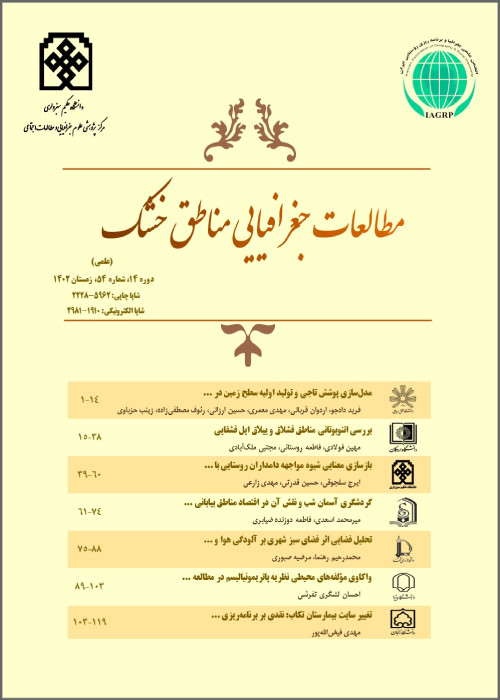Classification and determination of erodibility indices of marls in southeast of Pishva-Varamin area using rainfall simulator
Author(s):
Article Type:
Research/Original Article (دارای رتبه معتبر)
Abstract:
Introduction
Marl is one of the most important sedimentary units are in Iran because of the physicochemical characteristics and high rate of erodibility. These properties caused large civil damages and environmental impacts and so, the study of erosion and erodibility of the marl units is necessary. One of the most important points about marls is elements in them and grain size nature and their effects on amount of erosion. The chemical and physical proprieties of soil are very important in the development of badlands. This study deals with the physicochemical characteristics of the marl units and their effect on various forms of erosion in Pishva-Varamin region. Badlands are a typical landform of greatly dissected fine-grained materials in arid or semi-arid environments like Varamin, although they are also found in different climatic conditions. Badlands typically have steep, high drainage densities; high erosion rates, unvegetated slopes, and a tendency to form dried cracks in regolith profile, making the surface puffy. Geology and climate are several factors determining the tendency to badland formation. Marl, loose formations, runoff and rain splash, together with massive wasting processes such as creep, flow and sliding, become the dominant factors determining landform genesis, resulting in the formation of badlands in silty- clay slopes.Methodology
In this research, firstly, rain simulated (using field simulator) in five marl units in area with different forms of erosion, in addition to sampling the soil and sediments and then runoff and produced sediment amounts in each point were measured in laboratory. Also, parameters such as of sodium, potassium, calcium, magnesium, gypsum, electrical conductivity, content sedimentary particles agglomerate and SAR percent (SAR) were measured. In analyzing the data, analysis of variance and comparison of means method were used in SPSS software.Result and
Discussion
Grain-size composition, mineralogical, and geochemistry of soil and runoff chemistry parameters was characterized on both eroded (south-facing) and non-eroded (north-facing). Only a few grain-size parameters and silt and clay mineralogy discriminate eroded from non-eroded slope substrates. Erosion occurs where the fine fraction is abundant, mostly silt grains. This may be due to reduced permeability in the eroded soil, whereas the non-eroded one is more stable with respect to weathering, as it is more permeable. The abundance of clay minerals is affected by pedogenetic processes in the non-eroded slope, which increases in mixed layers and indirectly reduces the amounts of other minerals, making clay mineralogy a discriminating parameter in the two different types. Chemical data enable discrimination between eroded and non-eroded slopes. Parameters such as pH, SAR (sodium adsorption ratio), TDS (total dissolved salts) and PS (percentage of sodium) are distinctive parameters for both eroded and non-eroded slopes. TDS values increases in depth in the non-eroded slope, whereas the maximum TDS is just below the crust in the eroded one. Averagely, eroded substrates are higher in pH, SAR and PS than non-eroded ones. The ESP amount (exchangeable sodium percentage) of the eroded slope has a higher value than the non-eroded one. Crusts are less dispersive than eroded substrates, and non-eroded substrates behave as crusts. This suggests that the portion of the slope most severely exposed to weathering tends to stabilize, due to strong decreases in SAR, PS and ESP. Several diagrams reported in the literature show similarly anomalous crust samples on eroded slopes, compared with other samples coming from greater depths on eroded slopes. In the present case study, the exchangeable form of Na characterizes crusts more than the soluble form. The meaning of maximum SAR and TDS (and covariant parameters) is interpreted as the effect of decreased permeability, as suggested by a local increase in the fine-grained fraction, which coincides with maximum TDS. Variations in SAR values are of primary importance for soil erosion, because many authors have used solution chemistry (i.e., SAR, PS, TDS, EC) as a descriptor of dispersivity.Conclusion
Based on results of analysis of variance in various forms of erosion in Pishva area are significantly different in the sodium ion, sodium absorption ratio and the percentage of silt and clay. Percentage of silt size grains is one of the most important factors in soil erosion in this area. The average amount of sodium ion and sodium absorption ratio in marl samples of region, increase from sheet to gully erosion forms while average clay percentage decreases in this trend. Finally, three variables of sodium ions, sodium absorption ratio and clay percentage of marl samples can be significant factors in erosion and related forms in this region. This study describes the erosional mechanism, which involves morphological and geographic exposure and climatic elements, as well as grain size, mineralogy, chemistry and exchangeable processes of soils.Keywords:
Language:
Persian
Published:
Arid regions Geographic Studies, Volume:7 Issue: 26, 2017
Pages:
39 to 53
magiran.com/p1768588
دانلود و مطالعه متن این مقاله با یکی از روشهای زیر امکان پذیر است:
اشتراک شخصی
با عضویت و پرداخت آنلاین حق اشتراک یکساله به مبلغ 1,390,000ريال میتوانید 70 عنوان مطلب دانلود کنید!
اشتراک سازمانی
به کتابخانه دانشگاه یا محل کار خود پیشنهاد کنید تا اشتراک سازمانی این پایگاه را برای دسترسی نامحدود همه کاربران به متن مطالب تهیه نمایند!
توجه!
- حق عضویت دریافتی صرف حمایت از نشریات عضو و نگهداری، تکمیل و توسعه مگیران میشود.
- پرداخت حق اشتراک و دانلود مقالات اجازه بازنشر آن در سایر رسانههای چاپی و دیجیتال را به کاربر نمیدهد.
In order to view content subscription is required
Personal subscription
Subscribe magiran.com for 70 € euros via PayPal and download 70 articles during a year.
Organization subscription
Please contact us to subscribe your university or library for unlimited access!


